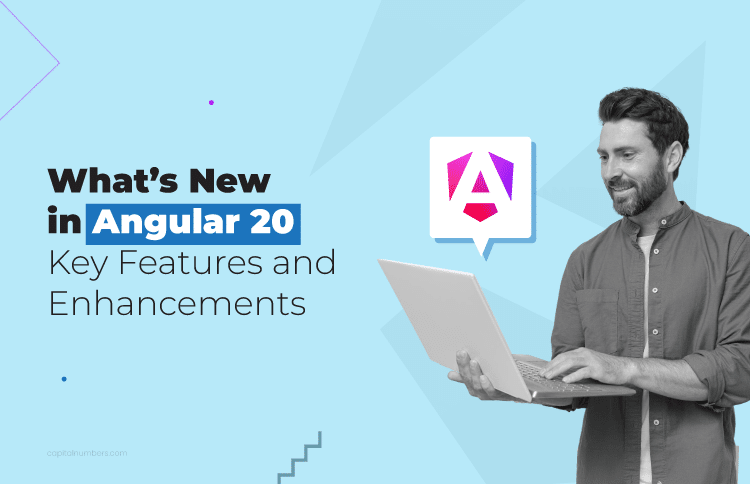What’s New in Angular 20: Key Features and Enhancements
Table of Contents
Angular 20, the latest version of Angular, brings exciting updates that will shape the future of web development. This release includes new features like signal-based reactivity, zoneless Angular for better performance, simplified configuration, and extended diagnostics to help developers work more efficiently. There are also improvements to dynamic component rendering and error handling, making it easier to build and maintain large-scale applications.
Here, we’ll go over these new features in Angular 20, why they matter, and how they can help improve your development projects. Keep reading to learn more about these updates and how they can benefit your team.
Why Developers Should Make the Move to Angular 20?
Angular has come a long way from its origins as AngularJS, continuously evolving to meet the growing demands of modern web development. The evolution of Angular has turned it into a powerful, modular, and performance-focused framework trusted by developers worldwide.
If you’re still using an older version of Angular, Angular 20 is the perfect opportunity to upgrade. This release brings crucial improvements that make your development process smoother, faster, and more efficient – from enhanced reactivity to smarter rendering.
Here’s why making the switch now just makes sense:
Performance Gains:
Angular 20 improves rendering speed and reduces memory use, making it perfect for large applications.
Developer Productivity:
With cleaner syntax, less repetitive code, and better error handling, Angular developers can work more efficiently. The improved debugging tools also help fix issues quicker.
Future-Proofing:
Features like signal-based reactivity and zoneless rendering ensure that your apps will be easier to maintain and scale.
Innovation at Scale:
The new features in Angular 20, like simplified configuration and dynamic rendering, make building large, flexible applications easier.
By upgrading to Angular 20, you’re not just enhancing your current projects but also preparing your team for future challenges.
Looking to build a top-tier Angular application?
Hire skilled Angular developers from Capital Numbers to build high-performance, scalable, and secure applications. Leverage the latest features in Angular 20 with our expert team, ensuring your solutions are built to meet your business goals.
Top Features in Angular 20

Angular 20 brings several exciting new features that make it easier to build scalable, high-performance applications. Let’s explore the key updates:
1. Signal APIs Are Now Stable
With Angular latest version, signal-based reactivity becomes a key feature for managing state in applications. This replaces traditional RxJS for state management, offering a simpler and more efficient way to handle reactivity, especially for real-time applications using Angular.
Signal-based reactivity simplifies change detection and improves performance by reducing the need for complex observables. The new signal APIs allow for more intuitive state updates, making it easier to manage real-time data and improving the overall developer experience.
Example Usage:
import { signal } from '@angular/core';
const countSignal = signal(0);
countSignal.update(value => value + 1); // Updates state reactively
In this example, countSignalc is a reactive signal that updates its state when the value changes, making it easier to track and update the application state.
Benefits of Signal-based Reactivity:
- Reduced Boilerplate: No more complex RxJS operators, making the code simpler and more readable.
- Better Debugging: Signals make behavior more predictable, helping with easier debugging of state management.
- Improved Performance: Faster rendering with simplified change detection, especially for large or real-time applications.
With Angular 20, this enhancement ensures smoother development and better performance for real-time applications and enterprise-level projects.
2. Zoneless Angular (Developer Preview)
Another great enhancement in Angular 20 is the option to remove zone.js for finer control over change detection. This feature aims to improve performance, reduce overhead, and enhance error handling in applications.
By disabling zone.js, Angular’s change detection becomes more predictable, allowing developers to manage updates more efficiently. This is particularly beneficial for real-time applications and performance-sensitive projects.
Example (Zoneless setup):
import { enableProdMode } from '@angular/core';
import { platformBrowser } from '@angular/platform-browser';
import { AppModule } from './app/app.module';
if (environment.production) {
enableProdMode();
}
platformBrowser().bootstrapModule(AppModule, { useZone: false });
In this example, zoneless Angular is enabled by setting { useZone: false } during the app’s bootstrap.
Implications for Developers:
- Better Compatibility: Works well with modern libraries and micro-frontends that do not rely on zone.js.
- More Control: Gives developers greater control over change detection, improving performance and making applications more predictable.
With zoneless Angular, developers can fine-tune performance and gain more flexibility when building complex, scalable applications.
3. Deprecations, Removals, and Breaking Changes
With the Angular 20 release, several older features have been deprecated and removed to make way for more efficient practices. This includes the removal of some lifecycle hooks and APIs, pushing developers to adopt newer, more modern methods.
For example, Angular 20 deprecates the ngOnChanges lifecycle hook in certain scenarios. Developers are now encouraged to use signal-based updates or ngOnInit for initialization tasks.
Example of Breaking Changes:
// Angular 20 deprecates the 'ngOnChanges' lifecycle hook in some scenarios.
// Replace with signal-based updates or use `ngOnInit` for initialization.
What to Prepare for in Migration:
- Check Deprecated Features: Be aware of the deprecated lifecycle hooks and APIs introduced in the latest version of Angular.
- Update Code: Migrate to newer methods like signal-based updates as part of your transition to Angular 20.
- Test Thoroughly: Ensure your application works well after the update and that all breaking changes are addressed.
As part of this feature enhancement in Angular 20, developers should follow a guide to Angular 20 to smoothly migrate to the new version while keeping apps efficient and up-to-date.
4. Enhanced Template Features
The Angular 20 release improves template syntax, making it easier and more efficient to create dynamic UIs. This includes simplified structural directives and better support for dynamic component rendering.
For example, Angular 20 replaces *ngIf and *ngFor with a new, cleaner syntax, making templates more readable and easier to manage.
Example: Replacing *ngIf and *ngFor with New Syntax:
<!-- Angular 20 -->
<div @if="isVisible">Content</div>
<ul>
<li @for="let item of items">{{ item.name }}</li>
</ul>
Additional Features:
- Dynamic Component Rendering: Easier handling of dynamic components in your app.
- Better Support for Inputs/Outputs: Improved integration for managing component inputs and outputs.
- Improved Debugging: New tools in Angular 20 make it easier to debug templates and handle errors.
With these feature enhancements in Angular 20, developers can create more efficient and readable templates, improving productivity and the app’s performance.
5. Extended Diagnostics
The Angular 20 release brings advanced diagnostics to help developers find performance issues, optimize bundles, and improve tree-shaking. These new features in Angular 20 make it easier to keep your app running efficiently.
Example of Diagnostics:
ng build --prod --stats-json
This command provides a detailed report to help you optimize your app’s build process.
Additional Features:
- Better Error Messages: The latest version of Angular provides clearer and more helpful error messages during runtime.
- Improved Debugging: The guide to Angular 20 shows how these new tools help you spot and fix issues early, keeping your code clean and efficient.
With these feature enhancements in Angular 20, developers can improve app performance, debug faster, and maintain high-quality code.
6. Error Handling Enhancements
The Angular 20 release brings important improvements to error handling, making it easier to manage errors and debug issues in your app. These updates help you handle errors more effectively in development and production environments.
- Improved Error Boundaries: Angular 20 provides better error boundary handling and clearer stack traces, making debugging easier.
- Customizable Global Error Handlers: You can now customize how errors are handled in different environments (like development and production).
Example of Global Error Handler:
import { ErrorHandler, Injectable } from '@angular/core';
@Injectable()
export class GlobalErrorHandler implements ErrorHandler {
handleError(error: any): void {
console.error('Global Error: ', error);
}
}
Additional Features:
- Easier Debugging: The latest version of Angular provides clearer error messages and better stack traces.
- Custom Error Handling: You can adjust error handling for different environments to suit your needs.
With these feature enhancements in Angular 20, developers can quickly spot and fix issues, improving the overall stability of the app.
7. Dynamically Created Components
The Angular 20 release makes it easier to create components dynamically at runtime, giving developers more flexibility. This is especially useful for managing dynamically loaded components in large applications.
Now, developers can load and manage components on demand, helping build more modular and scalable apps.
Example of Dynamically Creating Components:
import { ComponentFactoryResolver, Injector } from '@angular/core';
constructor(private resolver: ComponentFactoryResolver, private injector: Injector) {}
loadComponent(component: any) {
const factory = this.resolver.resolveComponentFactory(component);
const componentRef = factory.create(this.injector);
this.viewContainerRef.insert(componentRef.hostView);
}
Additional Features:
- Simplified Component Management: Angular 20 makes it easier to handle dynamically created components in large applications.
- More Control: Developers have more flexibility in how and when components are loaded, improving performance.
With these feature enhancements in Angular 20, developers can create more dynamic, modular apps with less complexity.
8. Simplified angular.json
The Angular 20 release simplifies the configuration of angular.json. This change reduces the complexity of managing different environments and build settings, especially for larger applications.
The new structure makes it easier to set up projects, mainly for enterprise-grade apps with multiple environments and deployment targets.
Example of New Structure:
{
"projects": {
"my-app": {
"architect": {
"build": {
"options": {
"outputPath": "dist/my-app"
}
}
}
}
}
}
Additional Features:
- Easier Configuration: The updated angular.json is simpler to manage, saving time and effort.
- Better Environment Management: It’s easier to handle different environments like production and development.
With these feature enhancements in Angular 20, managing and setting up projects is more straightforward and less error-prone.
9. Scroll Options and Resolvers
The Angular 20 release improves how scroll positions are handled. This makes it easier to maintain the user’s position in single-page applications (SPAs) when navigating between pages or sections, helping to provide a smoother and more consistent experience.
Also, advanced scroll behavior is now available, giving developers better control over scroll positions in complex navigation scenarios.
Example of Scroll Position Handling:
@HostListener('window:scroll', [])
onWindowScroll() {
this.scrollPosition = window.scrollY;
}
Additional Features:
- Better Scroll Control: Easier management of scroll positions, especially for SPAs with complex navigation.
- Improved Resolvers: More flexibility in handling route data and lifecycle events for smoother transitions.
With these feature enhancements in Angular 20, developers can create smoother navigation and more efficient route handling in dynamic applications.
You May Also Read: The Future of Front-End Development: Trends and Technologies to Watch
How to Switch to Angular 20?
Upgrading to Angular 20 involves simple steps to ensure a smooth transition. By managing dependencies, updating outdated features, and testing your app, you can easily take advantage of the new features in Angular 20. Here are the steps to guide you through the process:
A. Check Version Compatibility
- Ensure you’re using a recent version of Angular before starting the upgrade.
- Use ng update to analyze dependencies and identify any breaking changes.
B. Adopt Incrementally
- Start by using signals in new components and templates.
- Use dynamic component rendering when needed for more modular development.
C. Refactor Deprecations
- Replace deprecated features with newer Angular 20 equivalents.
- Review the updated angular.json and adjust your build settings.
D. Test and Debug
- Use Angular 20’s new diagnostics and error handling tools to catch issues early.
- Perform end-to-end testing for a smoother migration and fewer issues post-deployment.
E. Community Resources
- Use official Angular documentation and community guides to assist with the upgrade.
- Stay updated on solutions for any deprecated features or migration challenges.
By following these steps, you can smoothly upgrade to Angular 20 and enjoy the benefits of the latest features.
You May Also Read: Angular vs. React vs. Vue.js: Which is the Best Front-End Framework for Your Web App?
Bottom Line
Angular 20 brings key updates that will help future-proof your applications, especially with improvements in AI, dynamic rendering, and enterprise-level architecture. Upgrading to Angular 20 means better performance, easier maintenance, and access to the latest features for scalable and secure app development.
Still unsure whether to upgrade to Angular 20 or not? Don’t worry – talk to the expert developers at Capital Numbers and make an informed decision. Get in touch with us today!
Frequently Asked Questions
1. Should I upgrade to Angular 20?
Upgrading to Angular 20 is highly recommended for teams looking to improve performance, scalability, and maintainability. With updates to AI, dynamic rendering, and enterprise-level architecture, it’s a future-proof choice for your applications.
2. Can I upgrade directly to Angular 20?
It’s best to first check your current Angular version for compatibility. If you’re on a recent version (Angular 15 or later), the upgrade to Angular 20 will be smoother. Use the ng update command to check for dependencies and breaking changes.
3. Do I need to change my entire codebase for Angular 20?
You don’t need to refactor everything. Start by adopting Angular 20 features incrementally, like signals in new components or simplifying templates, while gradually replacing deprecated features.
4. How long will Angular 20 be supported?
Angular 20 will follow the usual support cycle, offering long-term support (LTS) for a set period. Typically, major versions of Angular receive active support for 18 months, with an additional 12 months of LTS. Be sure to stay updated on Angular’s release notes for exact dates.
5. Can I integrate Angular 20 with other frameworks or libraries?
Yes, Angular 20 can be integrated with a variety of libraries and frameworks like RxJS, NGXS, and even React or Vue.js in specific cases, allowing you to extend your application’s functionality while using Angular’s core features.


















